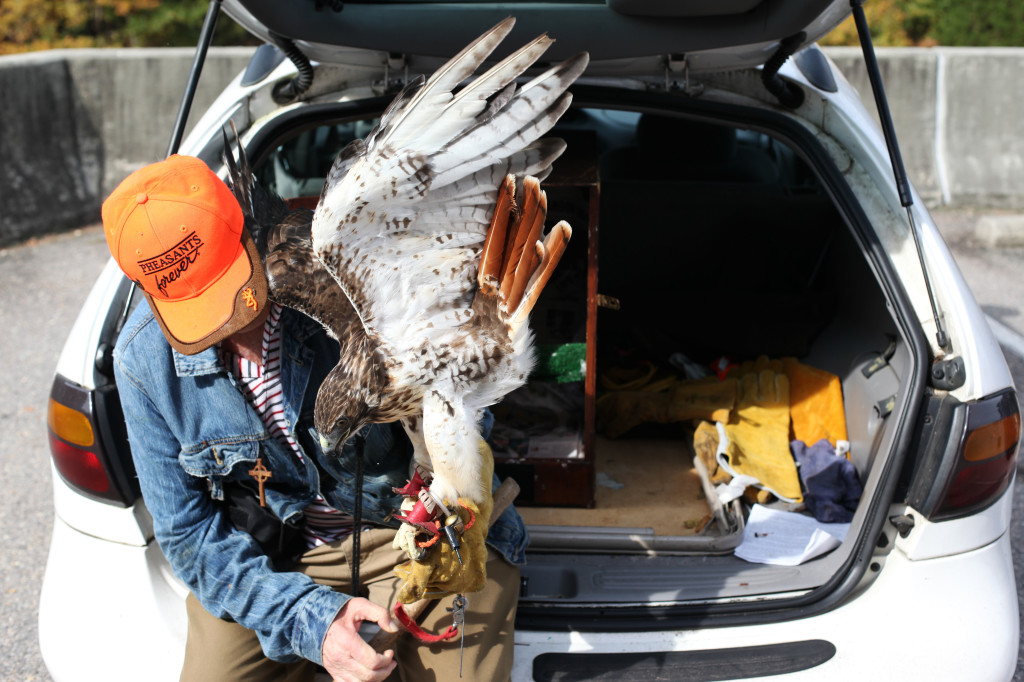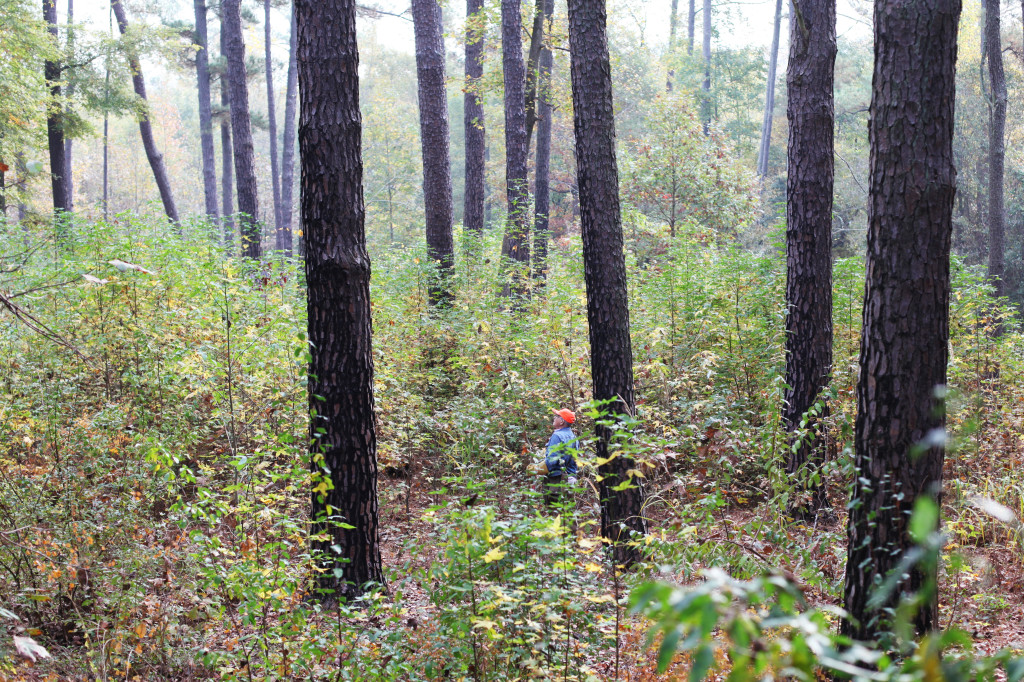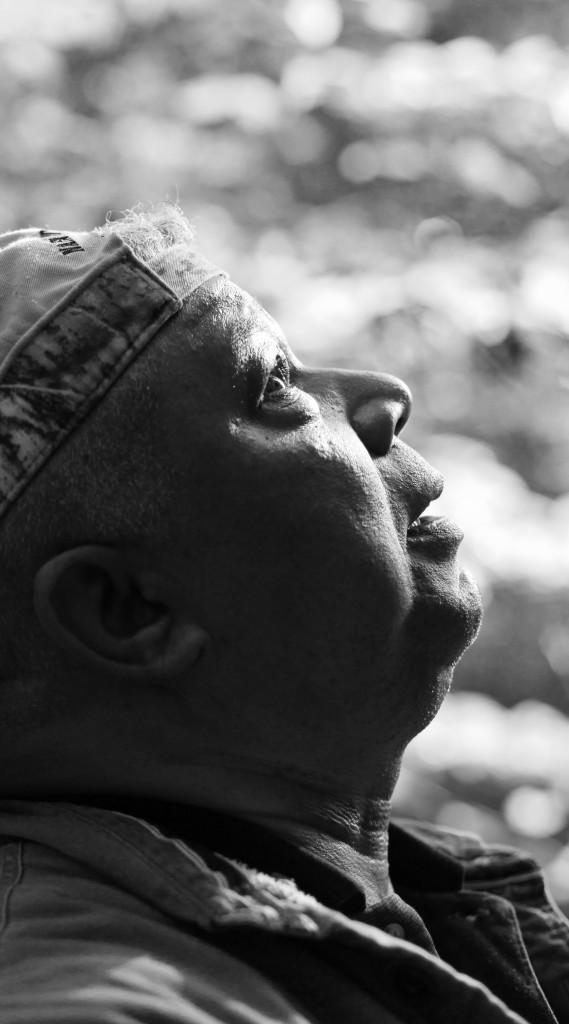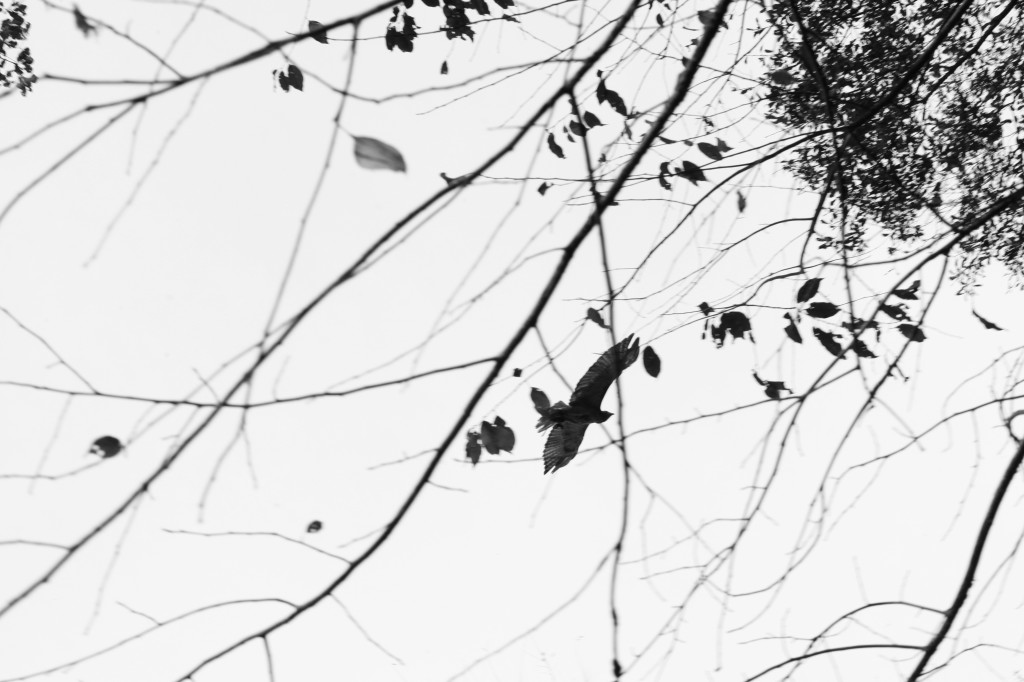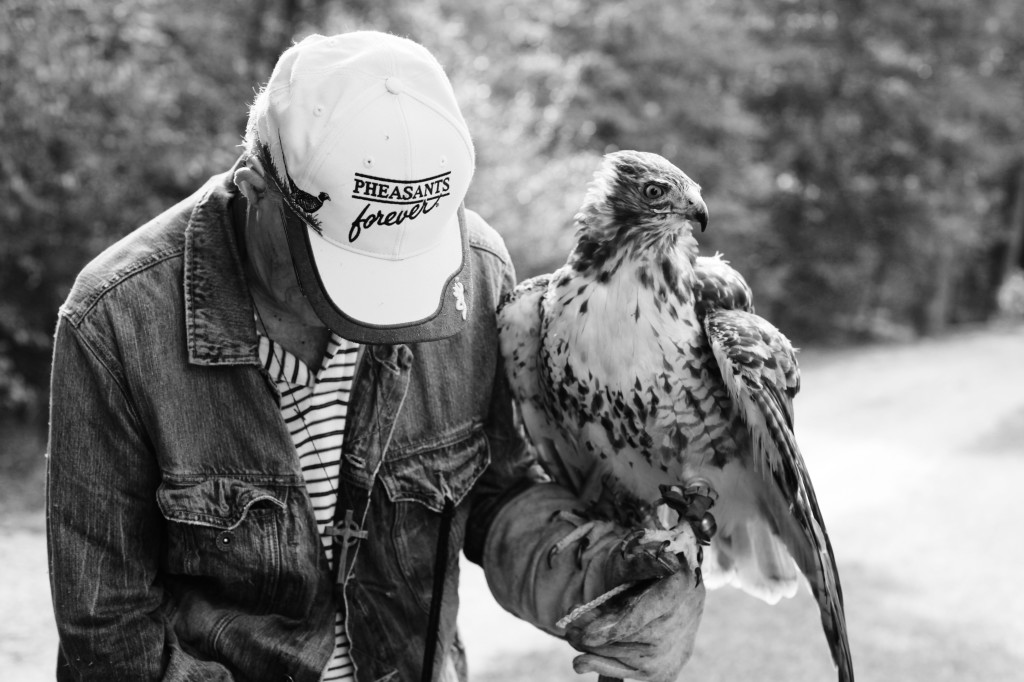This story ran in Walter Magazine in February 2014.
The hawk tenses on Bill Davis’s glove, eyes focused and brown-feathered wings wrapped tight around her body, and launches into flight. Her wings rear up, flashing the bird’s white underside, and her red tail feathers flare as she pulls herself through the air, quieter than a breeze except for the tingling bells tied near her feet. She trails two leather straps behind her, but she’s totally untethered as she disappears into trees thick with dying leaves. Davis can only trust that she’ll return. This is falconry.
It’s a rarefied sport and a failsafe topic of conversation, I have recently learned. Those who hunt with birds are always ready to talk about it, and those who don’t are eager to know more. From the uninitiated, incredulity comes first. Most people don’t realize that regular men and women are able to legally capture and turn wild birds of prey into free-flying hunting partners. And they do, right here in Raleigh.
Next comes intense curiosity. Before I went out with a falcon for the first time this fall, I giddily told everyone I knew, and fielded plenty of questions. Everyone’s interested because, basically, falconry sounds really cool. And it is. It’s also distinctly specialized: There are fewer than 100 falconers, or austringers, as they’re sometimes called when they fly hawks, in the North Carolina Falconers’ Guild. On any given day, you might find Raleigh’s few hunters flying in the game lands around Falls Lake or Lake Jordan, birds aloft and jingling with tiny bells, masters awaiting their return with leather-gloved hands.
The falconers’ goal, like the ancient hunters and European nobility who have gone before them for thousands of years, is to send a fine bird of prey out to capture small animals and return with them. The hunter helps to scare those critters up so his airborne partner can swoop down and capture one with deadly talons.
All this I learned in a $35 state-sponsored workshop in October. But learning about this sport in the classroom is one thing. Experiencing it first-hand is another.
“You wait ’til you start seeing her hunt,” Davis says as he takes Sandy, a red-tailed hawk, from a wooden box in the trunk of his Ford Taurus in the woods near Falls Lake one chilly morning. She’s small with her wings folded – about the size of a man’s upper arm – and instantly alert, seeming to blink in the morning light as her eyes flick across the scene.
Sandy’s a young but mature bird, weighing in a bit over two pounds. The feathers on her back are mottled shades of brown, her chest and the underside of her wings patterned white. She’s tensed and beautiful.
Davis, who lives in Cary, is 75. He’s been a falconer for 28 years. He got a late start but is now among the state guild’s most experienced hunters.
He and his friend James Caldwell, also a retiree, fly their birds about as often as most of us go to work. “Any day’s fine,” Davis tells me when I call to schedule a hunt with him. Even so, he says the excitement can get to him. As the bird perches on his thick leather glove, he tells me he couldn’t sleep the night before.
I lose sight of the hawk as soon as she flaps into the forest. Davis and Caldwell seem sure she’s waiting for us, so they pick their way into the pines after her.
Davis heads first toward an old graveyard hidden just off the park road, where he’s sure he can scare up some varmint for the bird. He pokes through the graves with a big wooden stick then leans over the chain-link fence to shake the bushes.
“Heygirl! Heygirl!” he shouts to Sandy. (I assume she is watching us from somewhere above.) Nothing moves. We head down the wooded hill, Davis and Caldwell taking separate paths through wide spaces between tall pines and maple.
Davis wears a faded denim jacket and a large, wooden cross necklace, Caldwell a thick cotton zip-up, both with hunters’ fluorescent orange ball caps. Davis’s reads “Pheasants Forever.” He roves ahead, rustling foliage and shouting up to the bird in the canopy to make sure she is nearby. “We do a lot of cheerleading,” he says, grabbing a wood vine to shake.
In falconry, unlike some other forms of hunting, it’s OK to make a racket.
I hear Sandy in the canopy as we walk – she’s quiet, but her bells give her away as she rustles on a branch or flies to a new perch.
Occasionally, Davis calls back, “Where is she, James?” He’s a good hunter but his hearing’s going and his childhood polio’s come back, hampering his movement. Davis is past the age when he can do this alone, even with falconry’s slow pace, Caldwell says.
Before this day in the woods, I thought falconry was outlandish, maybe even mythical. If it existed, I figured, it was practiced by an elite and wealthy secret society. Where I came up with that idea I don’t know – but I realized it was wrong when I walked into the Bullfrog Classroom in the basement level of the N.C. Wildlife Resources Commission building for a falconry “apprentices’ workshop.”
It was the Saturday before my outing with the two hunters. I’d told the guild that I wanted to write about falconry, and they were skeptical. There’s a lot to learn, the treasurer told me, and they’d seen plenty of misinformation printed. At the workshop, we students were warned: Falconry is not a half-hearted affair.
There were about a dozen of us – myself and three teenage kids, their parents, some college-aged guys and two middle-aged brothers, along with a contingent of veteran hunters from the North Carolina Falconers’ Guild.
I found myself nodding along as the guild members reverently described the hunting partnership – a walk through fields and woods, a bird’s shadow loyally following your own. Some parts sounded scarier than marriage.
“You’re taking on the responsibility of a bird,” said Richard Shores, the treasurer. “It’s your hunting partner for a long time. A bird might live 20 years.”
Before we could hunt, we were told, we’d need a birdhouse built that could resist a crafty aerial killing machine, and we’d have to convince a veteran falconer to give up precious hunting days to teach us the sport, as required by state law.
Then, after a hundred-question exam and some paperwork, we would be eligible to have our own bird of prey.
As I discovered via Google, sites like RaptorsForSale.com can get a red-tailed hawk shipped to RDU in a dog crate in a few days. Or one can do it the old-fashioned way, as Tammy Rundle, a representative of the state Wildlife Resources Commission, suggested.
“If you want to go out and have the full-fledged falconer experience,” she said, “you really should catch your first bird … I’ve seen it done, and there’s nothing like it.”
Nobody was willing to talk much about how they snare birds – they want to protect the animals from amateurs – but it involves trapping devices that don’t harm the raptor.
I chatted up some of my classmates during our caravan lunch trip to Cook-Out. Some, the college guys in particular, said they were just learning the system and wouldn’t get a bird for years.
Others were ready to dive in – like siblings, 14 and 11. They’d been obsessed with birds for a while, especially since they read My Side of the Mountain, a Newberry-award winning book about a boy and his peregrine falcon. They’d finally convinced their mother to let them try falconry. She seemed fully aware of what she was getting herself into.
“I’m the one with the driver’s license,” she said.
The two middle-aged brothers told me they wanted to get back to the hunt they loved as kids. They remember the day a man came to visit their neighborhood on the edge of Mexico City. He brought his bird and they were instantly taken in – but they hadn’t flown in 20 years, not since they came to the States.
It struck me how ordinary these people were. April, one of the guild members, said she was a senior tax analyst at a bank in Charlotte. Bill Davis, who gave a speech that day, is retired from Kentucky Fried Chicken and Kerr Drug. It’s a costly but manageable hobby to start – maybe $1,000 for all the equipment. But the real cost, everyone said, is time: days traveling to trap a bird, hours with the raptor on a tether, countless early mornings to get the animal out in the wild, where it wants to be.
Sandy certainly seems to want to be in the wild this afternoon, even though the hunting is not going so well. “There’s no one at home,” Caldwell says, looking over another empty squirrel’s nest.
An hour into the hunt we haven’t walked very far, but the two men have found plenty to see, from deer tracks to the flights of crows that scatter around Sandy.
“That’s an ancient war going on,” Caldwell says as the crows squabble.
Sometimes the two men seem to have adopted the raptor’s traits – its patience and eyesight, especially. They watch the woods with a darting gaze, scanning for prey as the hawk peers down from the canopy.
It’s an odd sensation, knowing that a mysterious animal is waiting above us, anticipating our movements and watching our cues. One doesn’t really train a hawk or a falcon, they tell me – what you teach it instead is that you’re a worthwhile partner. In fact, many falconers prefer to catch birds from nature because they already know how to hunt. Davis captured Sandy near Sanford.
The raptors stay wild at heart – you can return a hawk to the wilderness long after its capture, they say. Caldwell released one of his Harris hawks back to Arizona this year. He’s worried that he won’t be able to keep up with his birds as he ages. It was hard on him to watch the hawk fly off to join its kind – but the birds are never sentimental for their humans, according to my guides.
“Not a bit,” Davis says.
Still, we humans can’t help getting attached, Davis says. We usually don’t see these birds of prey but from a distance. They’re terrified of us, and perhaps we of them, but in falconry, they enter our world of cars and tethers and houses. They let us see them.
Davis and Caldwell don’t end up catching anything this day. Even though they’re sure that Davis and I were right behind a hare as we thrashed through a thicket, with Sandy watching from above – still, no varmint. The guys can’t believe it.
We end our hunt roadside. Davis calls to his bird, and she roosts in a tree’s crook. Then he casts a lure – a bright red little bag on a rope, which the hawk associates with food – and Sandy dives down, raising her wings up to shield the lure as she lands. It’s a little funny to me, how different the bird looks on the ground, all its feathers rolled up. When Davis pulls a piece of meat out, Sandy runs around him in what seems to me like needy excitement. And as they walk back, the bird resting on Davis’ arm, I can’t help but think there’s something more to this relationship than food.
Back at the cars, Caldwell pulls his own bird from her box so we can photograph her on the side of the road. As he shoots, two women jog by, then stop, then stare, then pull out phones for pictures. Next comes a man with a Bluetooth earpiece who begins to record a video of the guys, crouching, asking questions excitedly. A car stops, and another woman joins us. And then I look up and see no fewer than 20 small children marching down the road.
This, I think, is turning into a circus. Yet the kids and their guardians walk toward us as quiet as anything and line up to watch the birds. By the time I leave, Davis has the kids gathered around the back of his car. He’s cheerfully holding court, sitting in the open hatchback trunk with Sandy on his falconer’s glove, the kids watching agape, the bird staring cautiously back.

